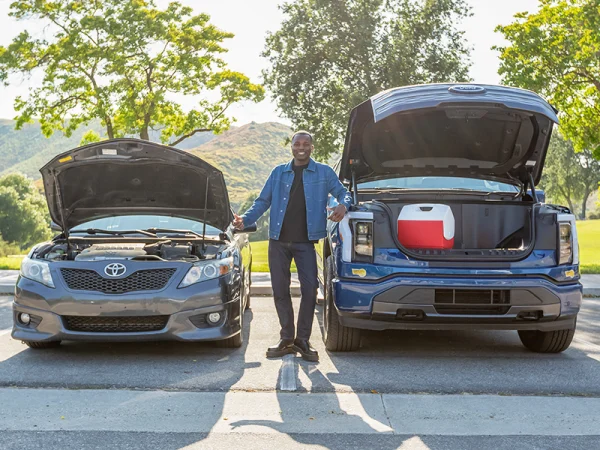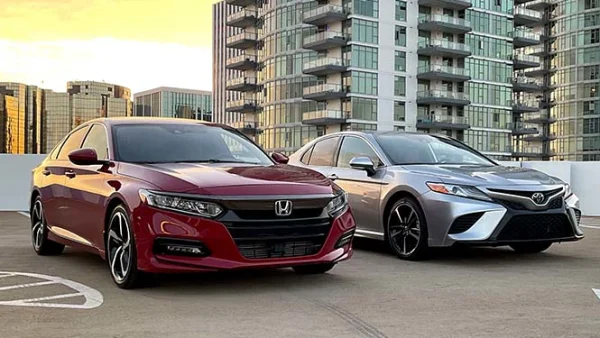2018 Toyota Camry review
Toyota Camry highlights
Customer rating
Mileage (EPA estimate)
22 city, 32 highway, 26 combined
Pricing for current inventory
From $21,998*
Shop with your budget in mind
Getting pre-qualified lets you shop with personalized monthly payments, and it doesn't impact your credit score.
All Toyota Camry years
Not sure what year to select? Learn about each Toyota Camry generation from 2012 to 2026
What is new for the 2018 Toyota Camry?
- New trim level added to the model lineup, enhancing options for buyers
- All models now include advanced safety features as standard equipment
- Updated infotainment system with improved connectivity and user interface
- New engine option available, offering better fuel efficiency and performance
2018 Toyota Camry trims
Curious how Toyota Camry trims differ? Use our side-by-side vehicle comparison to see the differences and similaritiesL:
- 203-hp, 184-lb-ft of torque 2.5L
- Cruise Control
- Automated Cruise Control
- Cloth Seats
- Lane Departure Warning
- Overhead Airbags
- Power Mirrors
- Rear Defroster
- Rear View Camera
- View our Toyota Camry L inventory
LE:
- Includes all features available on the L
- Power Seats
- View our Toyota Camry LE inventory
SE:
- Includes all features available on the LE
- Leatherette & Cloth
- Rear Spoiler
- View our Toyota Camry SE inventory
XSE:
- Includes all features available on the SE
- 206-hp, 186-lb-ft of torque 2.5L
- 301-hp, 267-lb-ft of torque 3.5L
- Blind Spot Monitor
- Front Seat Heaters
- Leather Seats
- Parking Sensors
- Smart Key
- Sunroofs
- Head Up Display
- Panoramic Sunroof
- View our Toyota Camry XSE inventory
XLE:
- Includes all features available on the XSE
- No significant upgrades found on the XLE
- View our Toyota Camry XLE inventory
Toyota Camry photos
1. Thrifty engine options
If you're looking for a sedan with fuel-sipping gas mileage, the 2018 Toyota Camry is a solid pick. The base 203-hp 2.5L four-cylinder engine with an eight-speed automatic transmission returns an EPA-estimated 29 mpg city and 41 mpg highway, helping you go farther between fill-ups.
A more potent 301-hp 3.5L V6 engine is optional on XLE and XSE trims if you want more muscle under the hood. With this powerplant, you can expect an EPA-estimated 22 mpg city and 33 mpg highway.2. Pleasing on-road dynamics
The 2018 Toyota Camry is an easy car to drive, whether cruising through the city or embracing the open road. The steering system is responsive and nicely weighted, and the sedan's suspension dampens rough ground. You'll reach passing speeds on the highway quickly regardless of engine choice, and the eight-speed automatic transmission delivers a pleasant driving experience. If you're craving sportier performance, the 2018 Toyota Camry SE has livelier dynamics, with a sport-tuned suspension, revised steering calibration, and paddle shifters.
3. Comfortable interior
Whether you like taking road trips or have to commute long distances, you'll be comfortable in the 2018 Toyota Camry. This five-passenger sedan features an airy cabin with supportive seating. Cloth upholstery and six-way manually adjustable front seats are standard, but you'll find leatherette trimming in the 2018 Toyota Camry SE, and leather upholstery in XLE and XSE trims. LE and higher trims also include an eight-way power-adjustable driver's seat with two-way power lumbar adjustment for more customization. With 15.1 cu-ft of cargo volume, you'll have room for luggage or sporting equipment in the trunk.
4. User-friendly tech
You don't have to climb the 2018 Toyota Camry's trim levels to enjoy great infotainment features. Base models come standard with Toyota's Entune™ interface, which has a seven-inch touchscreen display with Siri® Eyes Free, voice controls, and a rearview camera. Bluetooth® connectivity is also included, along with one USB port and a six-speaker sound system. If you want more bells and whistles, 2018 Camry XLE and XSE trims provide a larger eight-inch touchscreen display and an extra USB port. Wireless charging will keep your devices charged, and you'll enjoy premium sound from the nine-speaker JBL® sound system.
5. Driver aids galore
The 2018 Toyota Camry is packed with the latest driver aids to help you feel confident on your drive. All models include an advanced pre-collision system with pedestrian detection to keep you aware of obstacles in your path. Lane departure warning with steering assist and automatic high beams provide further support on busy highways and dark roads. In addition, adaptive cruise control can make stop-and-go traffic less stressful.
2018 Toyota Camry video review
The Toyota Camry was completely redesigned in 2018, getting a suite of new features on the inside, new looks on the outside, and two new available engines. In this video, Elana Scherr goes into all the details, covering what's changed, what the Camry has to offer, and which rivals give it the stiffest competition.
Shop with your budget in mind
Getting pre-qualified lets you shop with personalized monthly payments, and it doesn't impact your credit score.
Ratings & reliability
Customer ratings
4.4 out of 5
68 customer reviews| 5 Stars | 46 |
|---|---|
| 4 Stars | 13 |
| 3 Stars | 4 |
| 2 Stars | 2 |
| 1 Star | 3 |
RepairPal gave the Toyota Camry an overall reliability rating of 4.5 out of 5 stars, which RepairPal describes as Excellent. This rating ranks Toyota Camry 2nd out of 28 among Midsize Cars.
View RepairPal's full rating of the Toyota CamryToyota Camry features and specs
Curious how Toyota Camry trims differ? Use our side-by-side vehicle comparison to see the differences and similarities
XSE 4D Sedan 2WD
Standard Features
- Heated Mirrors
- ABS Brakes
- Air Conditioning
- Automated Cruise Control
- Blind Spot Monitor
- Front Seat Heaters
- Lane Departure Warning
- Leather Seats
- Overhead Airbags
- Parking Sensors
- Power Locks
- Power Mirrors
- Power Seat(s)
- Power Windows
- Rear Defroster
- Rear View Camera
- Side Airbags
- Smart Key
- Traction Control
- Alloy Wheels
- Rear Spoiler
- Automatic Transmission
- AM/FM Stereo
- Auxiliary Audio Input
- Bluetooth Technology
- Entune
- Head Up Display
- Panoramic Sunroof
- JBL Sound System
- Satellite Radio Ready
Drive Wheels
Front Wheel Drive (2WD)
Engine size
2.5L
Horsepower
206
Torque (ft-lbs)
186
Engine type
Gas
Fuel capacity
16
Wheelbase
111.2"
Overall length
192.7"
Width
72.4"
Height
56.9"
Leg room
F 42.1"/R 38"
Head room
F 38.3"/R 38"
Front tires
P235/40VR19
Rear tires
P235/40VR19
Seating capacity
5
Transmission
Automatic
2018 Toyota Camry FAQ
The eighth-generation Camry debuted in 2018, and was a big departure from 2017 and earlier models. The redesign included a new look, a new interior, new powertrains, an improved suspension design, and all sorts of technology updates.
Depending on the trim level, you get a different look in the front with various grille and headlight designs. The design is sharp and angular rather than rounded like the 2017 cars. This is particularly the case with the SE and XSE trims, which have a honeycomb-style grille. Other Camrys, such as the LE and XLE, are a little more conservative in their appearance.
When you pop the trunk in the new generation of Camrys, you’ll find 15.1 cubic feet of trunk space, which is an average amount for a midsize sedan. The trunk opens wide enough to accommodate a couple kids’ worth of sports gear, a stroller, a summer barbecue’s worth of groceries, or maybe all of them at once if you’re good at Tetris. A low lip makes it easy to lift heavy items out again. The Camry also has 60/40-split-folding rear seats should you need to carry something longer.
The Camry has always had a roomy interior with ample space for adults. This most recent model is no different. There's plenty of headroom in the front, even if you buy one with a sunroof, and plenty of legroom both front and rear. Rear headroom can be a little cramped for tall adults, however. And while there is plenty of space to install child seats in the rear, you’ll want to use some caution getting taller children in and out to keep from bonking their head ―or yours―on the door opening. The low roofline and relatively tight backseat space can make it tricky.
The driving position is neutral―not sports-car low or SUV high. There's good visibility due to big side windows and narrow windshield pillars that allow a broad view of the road ahead. It offers an available 360-degree top-down parking camera system that gives you a view of the car from above, so you can see any obstacles that might be out of your mirror view. It helps you squeeze into even the tightest of parallel parking spots.
The Camry offers driver-assist features, such as adaptive cruise control, blind-spot monitoring, and a lane-keeping assist system. Adaptive cruise control is a smart cruise control system that uses sensors to maintain a set distance from the car in front of you while cruise control is engaged. Blind-spot monitoring is designed to alert you when a car is passing or hanging out in the car's blind spot. And, lane-keeping assist is meant to provide small steering inputs when you drift out of your designated lane without signaling first.
At launch in 2018, the Camry lacked an optional integrated navigation system. Apple CarPlay® and Android Auto™ smartphone integration wasn't available either. The Camry got navigation and Apple CarPlay in 2019 and Android Auto for the 2020 model year.
Research other vehicles
- All things EV
- 2017 Ford F450 review
- 2018 Ford F450 review
- 2019 Ford F450 review
- 2021 Honda Pilot review
- 2022 Honda Pilot review
- 2023 Honda Pilot review
- 2017 Hyundai Ioniq Electric review
- 2018 Hyundai Ioniq Electric review
- 2019 Hyundai Ioniq Electric review
- 2012 Infiniti M35H review
- 2025 Mercedes-Benz GLE450 review
- 2016 Mercedes-Benz GLE450 AMG review
- Used Toyota buying guide
- 2025 Toyota Camry review
- 2012 Toyota Camry review
- 2013 Toyota Camry review
- 2015 Toyota Camry review
- 2017 Toyota Camry review
- 2021 Toyota Camry review
- 2022 Toyota Camry review
- 2023 Toyota Camry review
- 2024 Toyota Camry review
- 2025 Toyota Corolla Hybrid review
- 2018 Toyota Corolla iM review
- 2025 Volkswagen Golf review
- 2019 Volkswagen Golf Alltrack review
We hope you found this information helpful. This content is intended to inform and is not meant to indicate that a particular vehicle is currently available or recommended for you.
Statements of fuel economy or EV range are based on EPA and other third-party estimates for vehicles when new. Fuel economy and EV range will degrade with time and vary based on age, driving conditions, vehicle history, and other conditions. See fueleconomy.gov for more info.
Unless otherwise noted, information related to featured vehicles comes from third-party sources, including manufacturer information. Product and company names may be trademarks or registered trademarks of third-party entities. Use of them does not imply any affiliation with or endorsement by these entities. By clicking on any video links, you will be taken to a third-party site maintained by YouTube, Inc.
We make every effort to provide accurate information, but please verify before purchasing.













